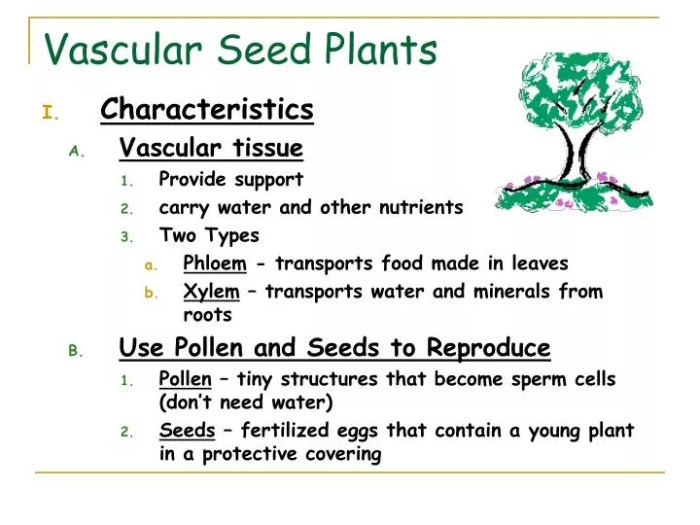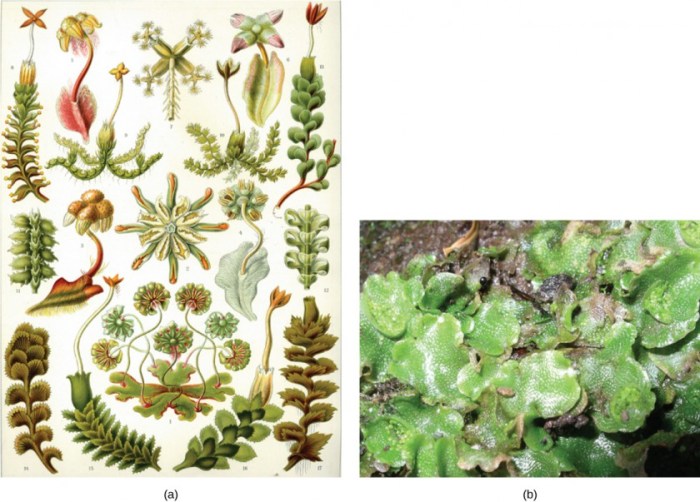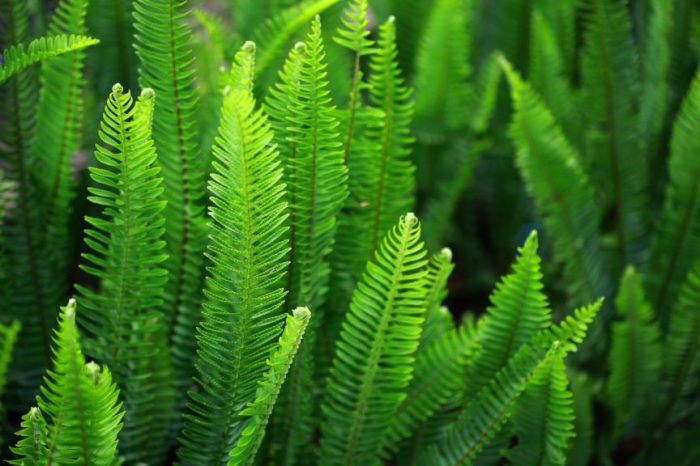Do All Vascular Plants Have Seeds?
Vascular Plants: A Deep Dive: Do All Vascular Plants Have Seeds

Source: slideserve.com
Do all vascular plants have seeds – Vascular plants, also known as tracheophytes, form the dominant plant life on Earth. Their success is largely due to the presence of specialized tissues for water and nutrient transport, allowing them to colonize diverse habitats. This exploration delves into the characteristics, diversity, and evolutionary history of vascular plants, focusing on the crucial role of seeds in their diversification.
Defining Vascular Plants
Vascular plants are characterized by the presence of vascular tissues: xylem and phloem. Xylem transports water and minerals from the roots to the rest of the plant, while phloem transports sugars produced during photosynthesis from the leaves to other parts. This efficient transport system allows for greater height and size compared to non-vascular plants. Examples include trees, shrubs, herbs, ferns, and conifers.
Xylem consists of specialized cells, including tracheids and vessel elements, which are dead at maturity and form hollow tubes. Phloem, on the other hand, is composed of living cells called sieve tube elements and companion cells. The interaction between these two tissues is vital for plant growth and survival.
| Plant Group | Xylem Characteristics | Phloem Characteristics | Example |
|---|---|---|---|
| Angiosperms | Vessel elements and tracheids present | Sieve tube elements with companion cells | Oak tree |
| Gymnosperms | Primarily tracheids | Sieve cells (lack companion cells) | Pine tree |
| Ferns | Tracheids | Sieve cells | Nephrolepis exaltata (Boston fern) |
Seed Plants: Gymnosperms and Angiosperms
Seed plants represent a significant evolutionary advancement, with seeds providing protection and nourishment for the embryo, enhancing survival and dispersal. This group is divided into gymnosperms and angiosperms, differing primarily in their seed structure and reproductive strategies.
Gymnosperms, meaning “naked seeds,” bear their seeds directly on the surface of cone scales. Examples include conifers (pines, spruces, firs), cycads, and ginkgoes. Angiosperms, or flowering plants, enclose their seeds within a fruit, derived from the ovary. This offers further protection and facilitates dispersal. Examples include roses, sunflowers, and oak trees.
| Characteristic | Gymnosperms | Angiosperms |
|---|---|---|
| Seed Structure | Naked seeds, borne on cone scales | Seeds enclosed within a fruit |
| Reproduction | Pollination by wind (mostly) | Pollination by wind, insects, birds, etc. |
| Examples | Pines, spruces, cycads | Roses, oaks, sunflowers |
Seedless Vascular Plants: Ferns and Allies
Seedless vascular plants, including ferns, lycophytes (club mosses), and horsetails, represent an earlier stage in the evolution of vascular plants. They lack seeds but possess vascular tissues for efficient water and nutrient transport. Reproduction in these plants relies on spores, dispersed by wind or water.
Ferns exhibit an alternation of generations, with a dominant sporophyte (diploid) phase and a smaller, independent gametophyte (haploid) phase. The sporophyte produces spores in structures called sporangia, which are often clustered in sori on the underside of fronds. The gametophyte, a small, heart-shaped structure called a prothallus, produces gametes (sperm and egg) that fuse to form a zygote, which develops into the sporophyte.
Fern Life Cycle Flowchart:
Sporophyte (diploid) → Spores (haploid) → Gametophyte (haploid) → Gametes (haploid) → Fertilization → Zygote (diploid) → Sporophyte (diploid)
Not all vascular plants produce seeds; some, like ferns, reproduce via spores. However, the question of seed production is relevant to whether you can successfully cultivate a new plant, as explored in this article: can you plant green bell pepper seeds. Since bell peppers are seed-bearing vascular plants, successful cultivation depends on factors beyond just the presence of seeds.
Therefore, the ability to reproduce via seeds is a key distinction within the vascular plant kingdom.
Evolutionary Relationships, Do all vascular plants have seeds
Seedless vascular plants preceded seed plants in evolutionary history. The evolution of seeds represented a major adaptive breakthrough, enhancing survival and dispersal capabilities. The evolutionary pathway leading to seeds involved several key adaptations, including the development of heterospory (production of two types of spores, microspores and megaspores), the retention of the megaspore within the megasporangium, and the evolution of the integument (protective layer around the megasporangium).
Illustrative Description of Evolutionary Pathway to Seeds: Imagine a timeline starting with simple, homosporous seedless vascular plants. Over time, heterospory emerges, leading to the differentiation of microspores (male) and megaspores (female). The megaspore is retained within the megasporangium, leading to the development of a megagametophyte (female gametophyte) that is nourished by the parent sporophyte. An integument develops around the megasporangium, providing further protection.
Finally, the ovule (integument + megasporangium + megagametophyte) is fertilized, resulting in the development of a seed.
Examples of Seedless Vascular Plants

Source: pressbooks.pub
- Equisetum arvense (Field Horsetail): A common weed found in disturbed habitats, characterized by jointed stems and whorls of scale-like leaves. Reproduction is through spores released from cone-like structures at the tip of fertile stems.
- Lycopodium clavatum (Running Clubmoss): A low-growing plant with small, scale-like leaves and long, trailing stems. It reproduces through spores produced in cone-like structures at the tips of upright branches.
- Dryopteris filix-mas (Male Fern): A large fern with prominent fronds, often found in shady, moist environments. Reproduction is through spores produced in sori on the underside of the fronds.
The Role of Seeds in Plant Success

Source: biologyonline.com
Seeds confer several advantages, enhancing plant success in diverse environments. The seed coat protects the embryo from desiccation and mechanical damage. Stored food reserves within the seed provide nourishment for the developing seedling, increasing its chances of survival. Seeds also facilitate dispersal, allowing plants to colonize new habitats. Different seed adaptations, such as wings, hooks, or fleshy fruits, contribute to dispersal by wind, animals, or water.
For example, wind-dispersed seeds often have wings or plumes (like maples), while animal-dispersed seeds may have hooks or fleshy fruits (like burrs or berries). Water-dispersed seeds are often buoyant and have adaptations to survive submersion (like coconuts).
Q&A
What are the advantages of having seeds?
Seeds offer several key advantages: enhanced dispersal, increased survival rates due to dormancy, and protection of the embryo.
Are all seedless vascular plants ferns?
No, while ferns are a prominent example, other seedless vascular plants include horsetails and club mosses.
How do seedless vascular plants reproduce?
Seedless vascular plants typically reproduce via spores, which are dispersed and germinate to produce a gametophyte generation that produces gametes for fertilization.
What is the oldest type of vascular plant?
Determining the absolute oldest is complex, but evidence suggests that early vascular plants appeared in the Silurian period.





















